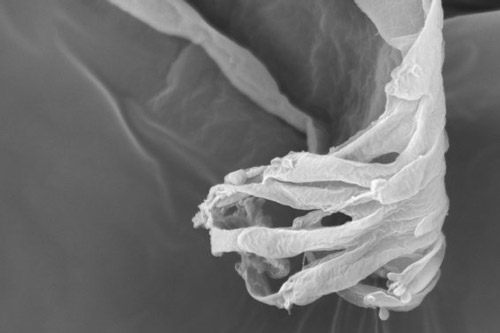The Tsetse Fly Has Strange, Sucker-Tipped Fingers on Its Mouth
New images could help scientists better understand how the flies transmit deadly sleeping sickness.

Sleeping sickness starts out as a fever, with joint pain and headaches. But by the time neurological symptoms set in—disrupted sleep cycles, confusion, loss of coordination—the disease’s effects are irreversible and can be fatal. According to the World Health Organization, about 2,800 cases were reported in 2015, with an estimated 20,000 unreported cases, but an estimated 300,000 cases went unreported and untreated as recently as 1998. In sub-Saharan Africa, where the protozoa-caused disease is transmitted by tsetse flies, about 65 million people are at risk of contracting it. The disease is a major public health priority, so scientists around the world are trying to learn more about the protozoa, and the flies that can introduce it to a person’s bloodstream. New images from British researchers suggest that we’ve been wrong in our understanding of how the tsetse fly’s mouth works.
When a tsetse fly bites a victim, it tears through skin and the walls of small blood vessels. But before it starts sucking up blood, it inserts a small tube into the vessel to inject some saliva, which has anticoagulant properties and keeps the blood flowing. “The textbooks just show a plain pointed end to the saliva tube,” said University of Bristol researcher Wendy Gibson in a press release. But when Gibson’s team took advantage of a new scanning electron microscope on the school’s campus and examined the tsetse fly’s mouth, they found that all the textbooks are wrong.

Instead of that plain pointed end, the tsetse fly’s saliva tube has “finger-like projections,” and, the team writes in a report, “on the tips of some are small sucker-like protrusions.” It’s hard to say right now exactly what the suckers and fingers are for besides terrifying people, but Gibson and her coauthors put forth a few ideas that could guide future research. The structures might help the fly sense the blood’s consistency or taste, or close off the end of the saliva tube. They could also regulate the flow of saliva or do something completely different. Understanding this is significant to understanding the disease pathway of sleeping sickness—and with such a serious infection, every bit of knowledge helps.




















Follow us on Twitter to get the latest on the world's hidden wonders.
Like us on Facebook to get the latest on the world's hidden wonders.
Follow us on Twitter Like us on Facebook